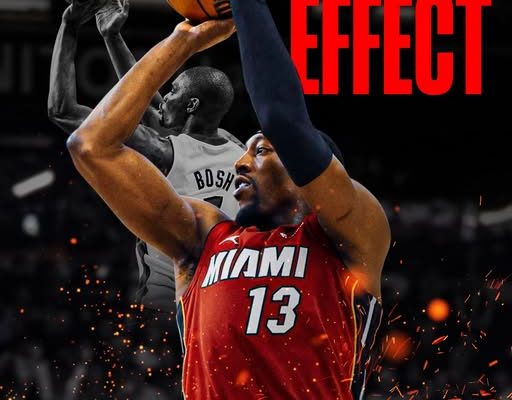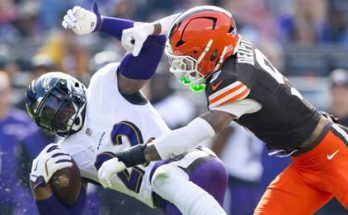Chris Bosh’s legacy in the NBA is one that often flies under the radar, overshadowed by the larger-than-life personalities of his Miami Heat teammates, LeBron James and Dwyane Wade. Yet, for those who truly understand the game of basketball, Bosh’s impact on the league and his team’s success is undeniable. A Hall of Fame player who sacrificed personal stats and glory for the greater good of his team, Bosh exemplified the qualities of a silent superstar. His presence was the glue that held together Miami’s legendary “Big 3,” and his unique skill set and unselfish play paved the way for the evolution of the modern big man—a path that players like Bam Adebayo now walk with pride and purpose.
Before joining the Heat in 2010, Chris Bosh was already a star in his own right. As the face of the Toronto Raptors franchise, Bosh earned five consecutive All-Star appearances and was widely regarded as one of the most versatile power forwards in the NBA. He averaged over 20 points and nearly 10 rebounds per game during his tenure in Toronto, displaying an offensive arsenal that included mid-range jumpers, post moves, and the ability to put the ball on the floor. Despite his individual brilliance, however, the Raptors struggled to find playoff success, and Bosh’s talents often went unnoticed on a national scale due to the team’s lack of postseason prominence. His decision to leave Toronto and join forces with LeBron James and Dwyane Wade was met with skepticism by some, who assumed Bosh would become a mere third wheel. What they didn’t realize was that his willingness to adapt and sacrifice would become the very foundation of Miami’s success.
When the Big 3 era began, the narrative focused almost entirely on LeBron and Wade. They were the superstars, the faces of highlight reels, the players expected to dominate every night. Bosh, however, quietly adjusted his game to complement them. He was no longer the first option or even the second. Instead, he embraced the role of a floor spacer, a defensive anchor, and a player willing to do all the little things that often go unnoticed but ultimately decide championships. Bosh developed a reliable three-point shot, extending his range to help create driving lanes for LeBron and Wade. His ability to stretch the floor was revolutionary for big men at the time, forcing opposing centers out of the paint and fundamentally changing how defenses had to approach the Heat’s offense.
Bosh’s defensive impact was perhaps his most underrated attribute. While he wasn’t the most physically imposing big man in terms of sheer size, his quickness, intelligence, and anticipation made him a nightmare for opponents. He could switch onto guards, contest shots on the perimeter, and still hold his ground in the post. In many ways, Bosh’s versatility on defense was ahead of its time, foreshadowing the current era of “positionless basketball” where big men are expected to guard multiple positions. During Miami’s playoff runs, Bosh was often tasked with guarding elite bigs while also covering for defensive breakdowns on the perimeter, a role that required both mental and physical discipline. His Game 6 performance in the 2013 NBA Finals, where he secured the offensive rebound that led to Ray Allen’s iconic three-pointer, remains one of the most clutch and selfless plays in basketball history. Without Bosh’s presence, Miami’s back-to-back titles in 2012 and 2013 would likely never have happened.
Bosh’s influence, however, extends beyond championships and highlights. His unselfish approach and willingness to adapt set a template for modern big men who are expected to do much more than just dominate in the post. Players like Bam Adebayo of the Miami Heat owe much of their stylistic versatility to the path that Bosh helped carve. Adebayo, who has emerged as one of the league’s most dynamic two-way centers, often plays a role similar to what Bosh once did—anchoring the defense while also initiating offense and spacing the floor. Both players share an ability to read the game, make quick decisions, and thrive in systems that prioritize ball movement and versatility over individual dominance. Bosh’s emphasis on spacing and switching on defense helped evolve Miami’s identity, and Adebayo has taken those principles to new heights, becoming a playmaking hub and defensive disruptor in ways that echo Bosh’s influence.
It’s easy to forget just how ahead of his time Chris Bosh was. During an era when many big men were still focused on traditional post-up scoring and rebounding, Bosh embraced a modern skill set. His ability to stretch defenses with his shooting, combined with his lateral quickness and mobility, was a precursor to today’s “stretch big” role that has become so valuable in the NBA. Players like Anthony Davis, Karl-Anthony Towns, and Kristaps Porzingis all benefit from the blueprint that Bosh helped design. He showed that a power forward or center could not only thrive outside of the paint but also be the key to unlocking spacing for elite perimeter players.
Despite his immense contributions, Bosh’s career was tragically cut short due to blood clots that forced him to retire early. At the time of his final season, he was still playing at an All-Star level, averaging over 19 points per game and continuing to be a vital piece for Miami. His abrupt departure from the game left a void, both for the Heat and for fans who admired his craft. However, his legacy has only grown stronger over time. The basketball community now recognizes just how crucial Bosh was to Miami’s success and how his style of play helped shape the modern NBA.
In comparing Bosh’s career to Bam Adebayo’s rise, it’s clear that the torch has been passed in more ways than one. Adebayo has often spoken about the impact Bosh has had on his development, praising his leadership and versatility. Much like Bosh, Bam is not the flashiest player on the court, but his ability to impact the game on both ends is undeniable. Bam’s defensive range, from guarding big men in the paint to switching onto guards, is reminiscent of Bosh’s defensive prowess. On offense, Adebayo’s passing and mid-range game reflect the adaptability that Bosh brought to the Heat during their championship years. In essence, Bam is the modern-day evolution of Bosh’s philosophy—a player who values team success above all and thrives in doing the dirty work that doesn’t always show up on the stat sheet.
Chris Bosh’s induction into the Hall of Fame cemented his status as one of the game’s greats, but his story is about much more than personal accolades. He represents the kind of superstar who doesn’t need constant validation through headlines or gaudy statistics. His greatness was in his ability to fit seamlessly alongside two other superstars, sacrificing numbers for rings, and redefining what it means to be a team-first player. In many ways, Bosh’s humility and willingness to adapt are what made the Heat’s Big 3 so successful. Without him, LeBron and Wade would not have had the space or defensive support to dominate in the ways they did.
Looking back on Miami’s Big 3 era, it’s clear that Chris Bosh was the unsung hero, the stabilizing force that allowed everything else to click. His ability to balance scoring, spacing, defense, and leadership was a rare combination, and it’s one that continues to influence the game today. As Bam Adebayo continues to grow into one of the league’s premier big men, the parallels to Bosh’s career are hard to ignore. Bam’s versatility, selflessness, and defensive brilliance are direct extensions of the foundation Bosh helped lay during his time in Miami.
Chris Bosh may never have been the loudest voice in the room or the player most likely to dominate the headlines, but his contributions to basketball are profound. He was a silent superstar, a player who understood that winning required sacrifice, adaptability, and a deep understanding of the game. His legacy lives on not just through the banners hanging in Miami but through the players like Bam Adebayo who embody his spirit of versatility and unselfishness. In the end, Bosh’s greatness lies not in the numbers he posted, but in the way he changed the game for those who came after him. He proved that a superstar doesn’t always need to be the face of the franchise to leave an indelible mark on the sport.



